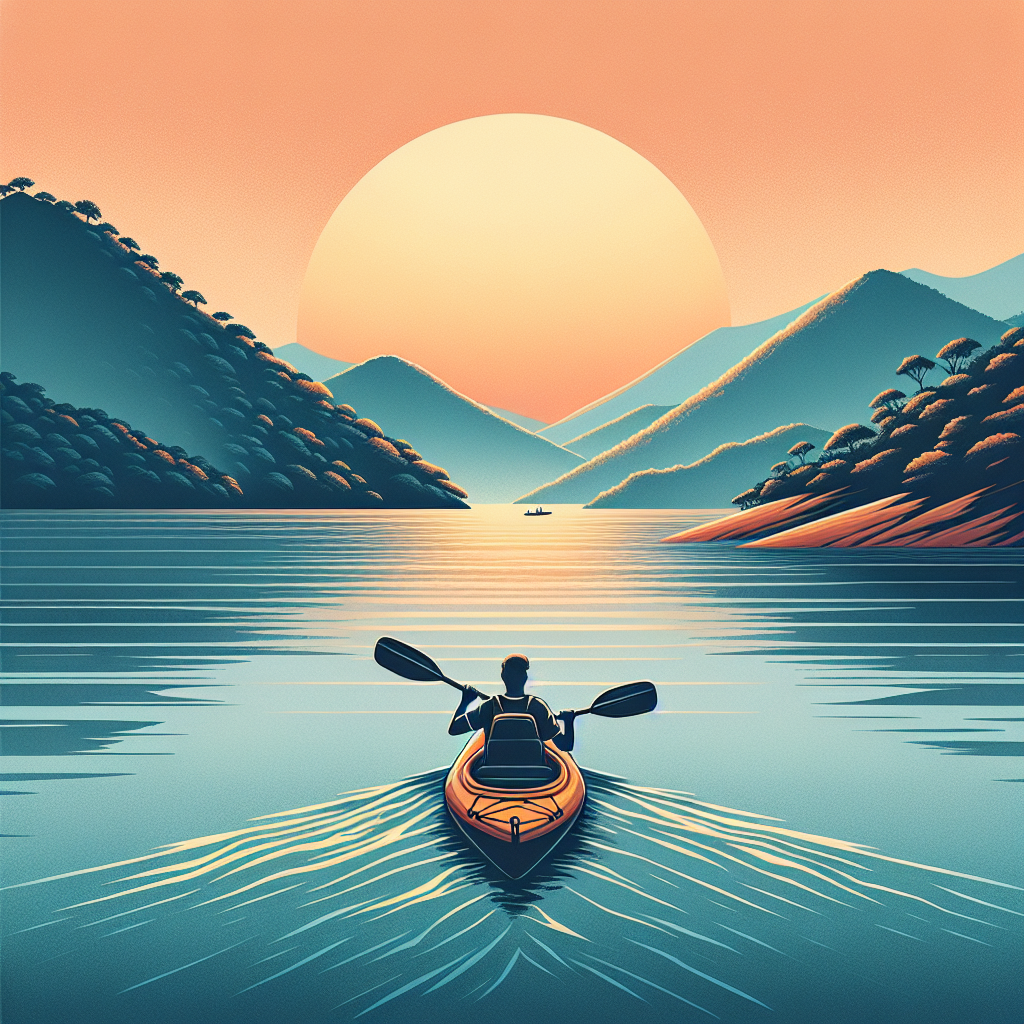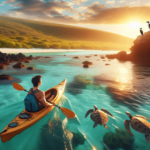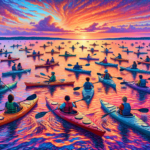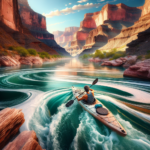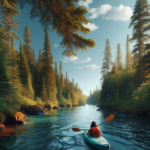Kayaking in Lake Kariba, Zimbabwe/Zambia
Introduction to Kayaking
Kayaking is an exhilarating outdoor activity that has gained immense popularity worldwide. It offers a unique blend of adventure, exercise, and a chance to connect with nature. Whether you’re paddling through serene lakes, navigating swift rivers, or exploring coastal waters, kayaking provides a thrilling experience that appeals to both beginners and seasoned adventurers. The sport’s versatility and accessibility make it a favorite among outdoor enthusiasts.
In this article, we will spotlight the unique features of kayaking in Lake Kariba, located on the border of Zimbabwe and Zambia. This destination offers a fantastic experience for kayaking enthusiasts, combining stunning landscapes, diverse wildlife, and a rich cultural backdrop. We’ll delve into what makes Lake Kariba a must-visit spot for anyone passionate about kayaking.
Kayaking in Lake Kariba is not just about the sport itself; it’s about immersing yourself in a unique environment. The lake’s vast expanse, dotted with islands and surrounded by rugged terrain, provides a picturesque setting for an unforgettable kayaking adventure. Whether you’re seeking tranquility or a bit of a challenge, Lake Kariba has something to offer.
So, let’s dive into the details of kayaking in Lake Kariba, Zimbabwe/Zambia, and discover why this location stands out as a premier destination for kayaking enthusiasts.
Overview of Kayaking in Lake Kariba, Zimbabwe/Zambia
Lake Kariba, one of the world’s largest man-made lakes, straddles the border between Zimbabwe and Zambia. Created in the late 1950s by damming the Zambezi River, the lake stretches over 220 kilometers in length and covers an area of approximately 5,580 square kilometers. Its vast waters and scenic surroundings make it an ideal location for kayaking and other water sports.
The climate around Lake Kariba is generally warm and tropical, with distinct wet and dry seasons. The best time to visit for kayaking is during the dry season, which runs from May to October. During this period, the weather is more predictable, and the water levels are stable, providing optimal conditions for kayaking. The wet season, from November to April, brings heavy rains and fluctuating water levels, which can make kayaking more challenging.
Visitors can access Lake Kariba from various points in both Zimbabwe and Zambia. The main access points in Zimbabwe include the towns of Kariba and Binga, while in Zambia, the town of Siavonga serves as a gateway to the lake. These towns offer various amenities, including accommodations, kayak rentals, and guided tours, making it convenient for visitors to plan their kayaking adventures.
Lake Kariba’s rich history and cultural significance add another layer of appeal to the kayaking experience. The lake is home to several fishing communities, and visitors can learn about the local way of life and traditional fishing practices. Additionally, the lake’s creation led to the relocation of the Tonga people, whose cultural heritage remains an integral part of the region’s identity.
Kayaking Conditions in Lake Kariba, Zimbabwe/Zambia
Lake Kariba offers a unique kayaking experience due to its vast expanse of calm waters. As a man-made lake, it lacks the strong currents and tides typically found in rivers and coastal areas, making it an ideal spot for both beginners and experienced kayakers. The lake’s surface is generally smooth, providing a stable environment for paddling.
The weather conditions around Lake Kariba vary throughout the year, impacting the kayaking experience. During the dry season (May to October), the weather is warm and sunny, with temperatures ranging from 20°C to 30°C (68°F to 86°F). This period is ideal for kayaking, as the water levels are stable, and the risk of sudden storms is minimal. The dry season also coincides with the peak tourist season, so it’s advisable to book accommodations and rentals in advance.
In contrast, the wet season (November to April) brings heavy rains and thunderstorms, which can make kayaking more challenging and unpredictable. Water levels in the lake can rise significantly, and strong winds may create choppy conditions. While some experienced kayakers may enjoy the added challenge, it’s generally recommended for beginners to avoid kayaking during this period.
One of the unique aspects of kayaking in Lake Kariba is the opportunity to explore its numerous islands and inlets. These areas offer sheltered waters and stunning scenery, making them perfect for leisurely paddling and wildlife spotting. The lake is home to a diverse range of wildlife, including hippos, crocodiles, and various bird species, providing kayakers with a chance to observe these animals in their natural habitat.
Top Spots for Kayaking in Lake Kariba, Zimbabwe/Zambia
Lake Kariba boasts several top spots for kayaking, each offering unique features and experiences. One of the most popular areas is the Matusadona National Park, located on the Zimbabwean side of the lake. This park is known for its stunning landscapes, abundant wildlife, and tranquil waters, making it a favorite among kayakers. Paddling along the shores of Matusadona, you can spot elephants, buffalo, and various bird species.
Another excellent spot for kayaking is the Sanyati Gorge, also on the Zimbabwean side of the lake. This narrow gorge, with its steep cliffs and crystal-clear waters, provides a dramatic backdrop for a kayaking adventure. The calm waters within the gorge make it an ideal location for beginners, while the stunning scenery will captivate even the most experienced kayakers. The best time to visit Sanyati Gorge is during the early morning or late afternoon when the light creates a magical atmosphere.
On the Zambian side, the Siavonga area offers several great kayaking spots. The waters around Siavonga are generally calm, making it a perfect location for leisurely paddling and exploring the lake’s numerous islands. One of the highlights of kayaking in this area is the opportunity to visit the local fishing villages and learn about traditional fishing practices. The best time to kayak in Siavonga is during the dry season when the weather is warm and stable.
For those seeking a more challenging kayaking experience, the waters around the Kariba Dam wall provide an exciting option. The currents near the dam can be stronger, offering a more dynamic paddling experience. However, it’s essential to exercise caution and ensure you have the necessary skills and equipment to navigate these waters safely. The best time to kayak near the dam wall is during the dry season when the water levels are more predictable.
Safety and Regulations
Safety is paramount when kayaking in Lake Kariba, and it’s essential to adhere to local regulations and guidelines. Both Zimbabwe and Zambia have specific rules governing water sports, including kayaking. These regulations are designed to ensure the safety of all participants and protect the lake’s natural environment.
One of the key safety recommendations is to always wear a life jacket while kayaking. Even if you’re an experienced swimmer, a life jacket provides essential buoyancy and can be a lifesaver in case of an emergency. Additionally, it’s advisable to carry a whistle or other signaling device to alert others if you need assistance.
It’s also important to be aware of the local wildlife, particularly hippos and crocodiles, which inhabit the lake. While these animals are generally not aggressive towards kayakers, it’s crucial to maintain a safe distance and avoid disturbing them. If you encounter a hippo or crocodile, remain calm and paddle away slowly without making sudden movements.
In case of an emergency, it’s essential to have a plan in place. Make sure you have a fully charged mobile phone or a VHF radio to call for help if needed. Familiarize yourself with the locations of nearby medical facilities and emergency services. Additionally, consider taking a first aid kit with you and learning basic first aid skills.
Amenities and Accommodations
Lake Kariba offers a range of amenities and accommodations to cater to the needs of kayaking enthusiasts. Several rental facilities around the lake provide kayaks, paddles, and safety gear, making it easy for visitors to access the necessary equipment. Additionally, guided tours are available for those who prefer to explore the lake with the assistance of an experienced guide.
Accommodation options around Lake Kariba are diverse, ranging from camping sites to luxury lodges. For those who enjoy camping, several designated camping areas offer basic facilities such as toilets and showers. These sites provide a more immersive experience, allowing you to connect with nature and enjoy the tranquility of the lake.
If you prefer more comfort, there are numerous lodges and hotels around the lake, offering a range of amenities such as swimming pools, restaurants, and spa services. Some lodges also provide guided kayaking tours and other water-based activities, making it convenient for visitors to plan their adventures. Popular lodges include Bumi Hills Safari Lodge and Caribbea Bay Resort.
In addition to kayaking, Lake Kariba offers various recreational activities for visitors to enjoy. Fishing is a popular pastime, with the lake being home to several fish species, including the famous tiger fish. Boat cruises are another great way to explore the lake and its surroundings, offering opportunities for wildlife spotting and photography.
Environmental Considerations
Preserving the natural habitats and wildlife of Lake Kariba is of utmost importance. As a kayaker, it’s essential to practice eco-friendly kayaking to minimize your impact on the environment. One of the key principles is to leave no trace, meaning you should take all your trash with you and avoid disturbing the natural surroundings.
When kayaking in Lake Kariba, it’s important to respect the local wildlife. Avoid approaching or disturbing animals, particularly hippos and crocodiles, which can be dangerous if provoked. Additionally, be mindful of bird nesting areas and avoid paddling too close to them to prevent causing stress to the birds.
Supporting local conservation efforts is another way to contribute to the preservation of Lake Kariba’s natural environment. Several organizations and projects focus on protecting the lake’s wildlife and habitats. Consider making a donation or participating in volunteer programs to support these initiatives. One such organization is the Zambezi Society, which works to conserve the Zambezi River and its ecosystems.
Using eco-friendly gear and equipment is also important. Opt for reusable water bottles and containers instead of single-use plastics. Additionally, choose biodegradable sunscreen and insect repellent to minimize the impact on the lake’s water quality. By making these small changes, you can help protect Lake Kariba’s environment for future generations.
Highlights
When comparing kayaking in Lake Kariba to other popular kayaking destinations, several unique features stand out. One of the most notable aspects is the lake’s vast expanse and diverse landscapes. Unlike many other kayaking locations, Lake Kariba offers a mix of open waters, narrow gorges, and numerous islands, providing a varied and dynamic paddling experience.
The biodiversity of Lake Kariba is another highlight. The lake is home to a wide range of wildlife, including hippos, crocodiles, elephants, and various bird species. This rich biodiversity makes kayaking in Lake Kariba a unique opportunity for wildlife enthusiasts to observe these animals in their natural habitat. The presence of large mammals such as elephants and hippos sets Lake Kariba apart from many other kayaking destinations.
Geographically, Lake Kariba’s location on the border of Zimbabwe and Zambia adds to its appeal. The lake’s creation by damming the Zambezi River has resulted in a unique landscape that combines rugged terrain with serene waters. The dramatic scenery, particularly in areas like Sanyati Gorge and Matusadona National Park, provides a stunning backdrop for kayaking adventures.
Historically, Lake Kariba holds significant cultural importance. The relocation of the Tonga people during the lake’s creation and their enduring cultural heritage add a layer of depth to the kayaking experience. Visitors have the opportunity to learn about the local culture and history, making their kayaking adventure not just a physical activity but also a cultural journey.
FAQ Section
- What is the best season to go kayaking in Lake Kariba? The best season for kayaking in Lake Kariba is during the dry season, from May to October, when the weather is warm and stable.
- Are there beginner-friendly spots for kayaking in Lake Kariba? Yes, areas like Sanyati Gorge and the waters around Siavonga are ideal for beginners due to their calm and sheltered conditions.
- What should I bring for a kayaking trip in Lake Kariba? Essential items include a life jacket, sunscreen, a hat, a reusable water bottle, a whistle, and a fully charged mobile phone or VHF radio.
- Are kayak rentals available at Lake Kariba? Yes, several rental facilities around the lake provide kayaks, paddles, and safety gear.
- How can I participate in local conservation efforts? You can support organizations like the Zambezi Society through donations or volunteer programs focused on protecting the lake’s wildlife and habitats.
- Are guided kayaking tours available? Yes, guided tours are available and offer an excellent way to explore the lake with the assistance of an experienced guide.
- What safety measures should I take while kayaking in Lake Kariba? Always wear a life jacket, carry a whistle or signaling device, maintain a safe distance from wildlife, and have a plan in place for emergencies.
Final Thoughts
Kayaking in Lake Kariba, Zimbabwe/Zambia, is a premier destination for kayaking enthusiasts, offering a unique blend of adventure, stunning landscapes, and rich biodiversity. The lake’s vast expanse, diverse wildlife, and cultural significance make it a must-visit spot for anyone passionate about kayaking. Whether you’re a beginner or an experienced paddler, Lake Kariba has something to offer.
As you plan your kayaking adventure, it’s essential to respect local guidelines and conservation efforts. By practicing eco-friendly kayaking and supporting local conservation initiatives, you can help preserve Lake Kariba’s natural environment for future generations. Remember to always prioritize safety and adhere to local regulations to ensure a safe and enjoyable experience.
In conclusion, Lake Kariba offers an unparalleled kayaking experience that combines the thrill of paddling with the beauty of nature and the richness of local culture. So, pack your gear, plan your trip, and get ready to explore the breathtaking waters of Lake Kariba. Your adventure awaits!

